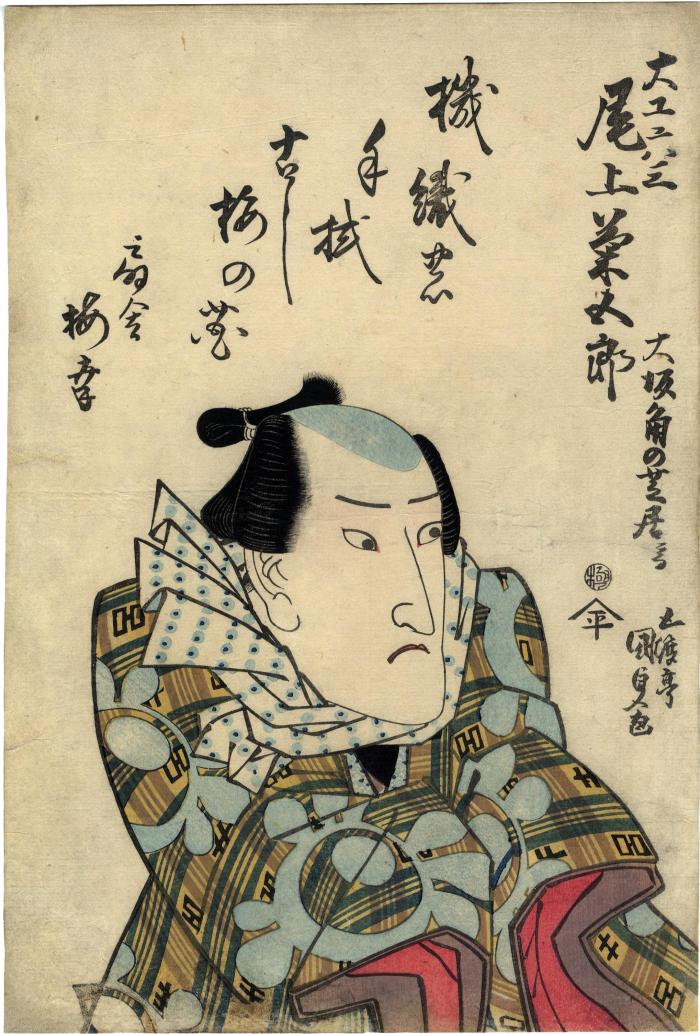Utagawa Kunisada (歌川国貞) / Toyokuni III (三代豊国) (artist 1786 – 01/12/1865)
Onoe Kikugorō III (尾上菊五郎 ) as the carpenter or daiku Rokuzo ( 大工六三) from the play Keisei Date No Kikigaki (けいせい伊達抄) - from an untitled series
01/1826
10.125 in x 15 in (Overall dimensions) Japanese woodblock print
Signed: Gototei Kunisada ga
五渡亭国貞画
Publisher: Ōmiya Heihachi
(Marks 413 - seal 01-108)
Censor's seal: kiwame
Ritsumeikan University
Museum of Fine Arts, Boston - 1826 Ashiyuki print of Kikugorō III as Rokuza in the same play
Museum of Fine Arts, Boston - 1858 Toyokuni III print of Rokuza
Lyon Collection - 1852 Kuniyoshi and Yoshiiku print of Rokuza fighting a giant carp
Lyon Collection - another print from this series
Ritsumeikan University - all eight prints from this series over two pages
British Museum - dated 1/1826 - donated by Dr. Ellis Tinios Hidden within the plaid pattern of this actor's robe is a secret to his name. "The letters 'ki' and 'ro' are in the checkered pattern formed by the four vertical lines and five horizontal lines. And in this way, the puzzle can be read as 'Kikugoro.' "
Quoted from: Pattern Sourcebook: Japanese Style 2 by Shigaki Nakamura, p. 14.
Karen Marks described this pattern on a print by a different artist in an article on yukata worn during the Edo period: "A similar play on words can be found in the signature design of Onoe Gorō III depicted in the print by Utagawa Kuniyasu (1794-1832). The actor is depicted on stage in the role of Tamaya Shinbei. His kimono has a design of four vertical stripes and five horizontal ones, and in between the hiragana character for “ki” and the Sino-Japanese character pronounced “ro.” Five is pronounced “go” in Japanese and the stripes added together make nine, pronounced “ku.” Combined together this rebus reads “ki-ku-go-ro” forming the actor’s name. This design too, called “Kikugorō-kōshi,” is now commonly seen in men’s yukata..."
****
The poem reads: 機織の手拭古し梅の花 扇舎梅幸
Loosely translated it means: "Old woven hand towel with plum blossoms" Ōgisha Baikō [Baikō is one of the poetry names of Onoe Kikugorō III.]
The transliteration at the British Museum is given as: Hataori no tenugui furushi ume no hana Ogiya Baiko
Note the differences between the Google translation of the actor's name vs. that of the British Museum: Ōgisha Baikō / Ogiya Baiko [Also note that generally the British Museum does not give the diacritical marks used in translations to English from Japanese.]
****
This actor's robe is decorated with a light blue, highly stylized crest of plum blossoms.
****
There is another copy of this print at the Hagi Uragami Museum.
Onoe Kikugorō III (三代目尾上菊五郎: 11/1815-3/1848) (actor)
Ōmiya Heihachi (近江屋平八) (publisher)
actor prints (yakusha-e - 役者絵) (genre)
ōkubi-e (大首絵) (genre)
